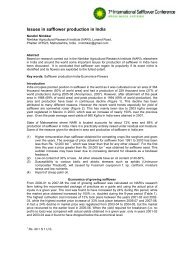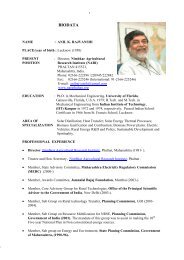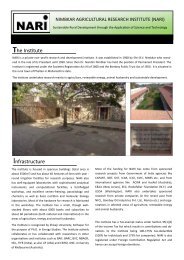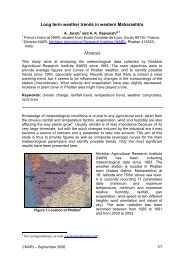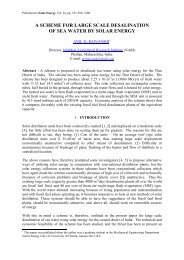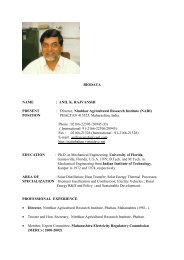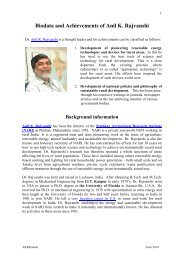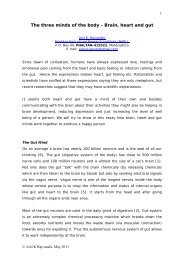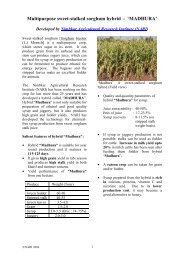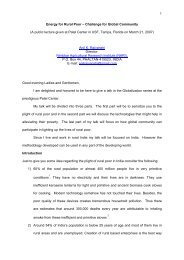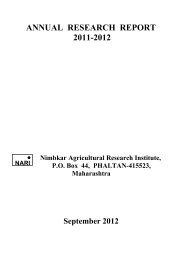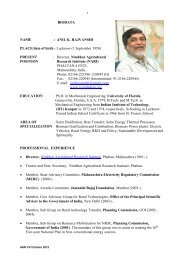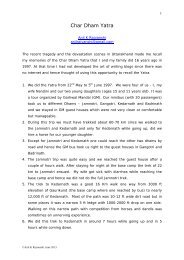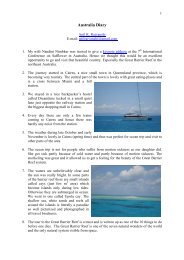Safflower (Carthamus tinctorius L.) - NARI
Safflower (Carthamus tinctorius L.) - NARI
Safflower (Carthamus tinctorius L.) - NARI
You also want an ePaper? Increase the reach of your titles
YUMPU automatically turns print PDFs into web optimized ePapers that Google loves.
3639_C006.fm Page 194 Wednesday, July 19, 2006 1:30 PM194 GENETIC RESOURCES, CHROMOSOME ENGINEERING, AND CROP IMPROVEMENTSingh, V. and N. Nimbkar. 1993. Genetics of aphid resistance in safflower (<strong>Carthamus</strong> <strong>tinctorius</strong> L.). Sesame<strong>Safflower</strong> Newsl. 8: 101–106.Singh, V., D.R. Rathod, M.B. Deshpande, S.R. Deshmukh, and N. Nimbkar. 2003b. Breeding for wilt resistancein safflower. In Extended Summaries. National Seminar on “Stress Management in Oilseeds forAttaining Self-Reliance in Vegetable Oils,” Hyderabad, India, January 28–30, 2003. ISOR, Directorateof Oilseeds Research, pp. 368–370.Smith, J.R. 1996. <strong>Safflower</strong>. AOCS Press, Champaign, IL, p. 624.Suganya, A., M. Sujatha, and K.R. Sastry. 1997. In vitro selection for resistance to Fusarium oxysporum Schlecht.carthami Klisiewiez and Houston in safflower. In Proceedings of the 4th International <strong>Safflower</strong>Conference: <strong>Safflower</strong>: A Multipurpose Species with Unexploited Potential and World Adaptability,Adriatica, Editrice, Bari, Italy, June 2–7, 1997. Corleto, A. and Mundel, H.H., Eds., pp. 305–308.Sujatha, M. and A. Suganya. 1996. In vitro organogenic comparison of different seedling tissues of safflower(<strong>Carthamus</strong> <strong>tinctorius</strong> L.). Sesame <strong>Safflower</strong> Newsl. 11: 85–90.Tejovathi, G. and S.Y. Anwar. 1987. Plant regeneration from cotyledonary cultures of safflower (<strong>Carthamus</strong><strong>tinctorius</strong> L.). In Proceedings of the National Symposium “Plant Cell and Tissue Culture of EconomicallyImportant Plants,” Hyderabad, India. Reddy, G.M., Ed., pp. 347–354.Tejovathi, G. and S.Y. Anwar. 1993. 2,4,5-trichlorophenoxy propionic acid induced rhizogenesis in <strong>Carthamus</strong><strong>tinctorius</strong> L. Proc. Ind. Natl. Sci. Acad. B59: 633–636.Thomas, C.A. 1964. Registration of ‘US10’ safflower. Crop Sci. 4: 446–447.Thomas, C.A. 1971. Registration of ‘VFR-1’ safflower germplasm. Crop Sci. 11: 606.Urie, A.L. 1981. Continued studies on inheritance of partial hull in safflower (<strong>Carthamus</strong> <strong>tinctorius</strong> L.).In Proceedings of the 1st International <strong>Safflower</strong> Conference, Davis, CA, July 12–16, 1981, pp. 264–271.Urie, A.L. 1986. Inheritance of partial hull in safflower. Crop Sci. 26: 493–498.Urie, A.L., W.F. Peterson, and P.F. Knowles. 1979. Registration of “Oleic Leed” safflower. Crop Sci. 19: 747.Urie, A.L. and D.E. Zimmer. 1970a. Yield reduction in safflower hybrids caused by female selfs. Crop Sci.10: 419–422.Urie, A.L. and D.E. Zimmer. 1970b. Registration of reduced-hull safflower lines, reduced hull-1, -2, -3 and -4.Crop Sci. 10: 732.van Rooijen, G.J., L.I. Terning, and M.M. Moloney. 1992. Nucleotide sequence of an Arabidopsis thalianaoleosin gene. Plant Mol. Biol. 18: 1177–1179.Vavilov, N.I. 1951. The Origin, Variation, Immunity and Breeding of Cultivated Plants. Ronald Press Company,New York, 1951, 364 pp.Velasco, L. and J. Fernandez-Martinez. 2001. Breeding for oil quality in safflower. In Proceedings of the5th International <strong>Safflower</strong> Conference, Williston, ND, and Sidney, MT, July 23–27, 2001. Bergman, J.W.and H.H. Mundel, Eds., pp. 133–137.Vilatersana, R., T. Garnatje, A. Susanna, and N. Garcia-Jacas. 2005. Taxonomic problems in <strong>Carthamus</strong>(Asteraceae): RAPD markers and sectional classification. Bot. J. Linn. Soc. 147: 375–383.Vilatersana, R., A. Susanna, N. Garcia-Jacas, and T. Garnatje. 2000. Karyology, generic delineation anddysploidy in the genera Carduncellus, <strong>Carthamus</strong> and Phonus (Asteraceae). Bot. J. Linn. Soc. 134:425–438.Walia, N., A. Kaur, and S.B. Babbar. 2005. In vitro regeneration of a high oil-yielding variety of safflower(<strong>Carthamus</strong> <strong>tinctorius</strong> var. HUS-305). J. Plant Biochem. Biotech. 14: 1–4.Weiss, E.A. 1971. Castor, Sesame and <strong>Safflower</strong>. Leonard Hill Books, London, pp. 529–744.Yazdi-Samadi, B., R. Maali Amiri, M.R. Ghannadha, and C. Abd-Mishani. 2001. Detection of DNA polymorphismin landrace populations of safflower in Iran using RAPD-PCR technique. In Proceedingsof the 5th International <strong>Safflower</strong> Conference, Williston, ND, and Sidney, MT, July 23–27, 2001.Bergman, J.W. and H.H. Mundel, Eds., p. 163.Ying, M., W.E. Dyer, and J.W. Bergman. 1992. Agrobacterium tumefaciens-mediated transformation ofsafflower (<strong>Carthamus</strong> <strong>tinctorius</strong> L.) cv. ‘Centennial’. Plant Cell Rep. 11: 581–585.Zhang, Z. 2001. Genetic diversity and classification of safflower (<strong>Carthamus</strong> <strong>tinctorius</strong> L.) germplasm byisozyme techniques. In Proceedings of the 5th International <strong>Safflower</strong> Conference, Williston, ND,and Sidney, MT, July 23–27, 2001. Bergman, J.W. and H.H. Mundel, Eds., pp. 157–162.Zhaomu, W. and D. Lijie. 2001. Current situation and prospects of safflower products development in China.In Proceedings of the 5th International <strong>Safflower</strong> Conference, Williston, ND, and Sidney, MT,July 23–27, 2001. Bergman, J.W. and H.H. Mundel, Eds., pp. 315–319.



